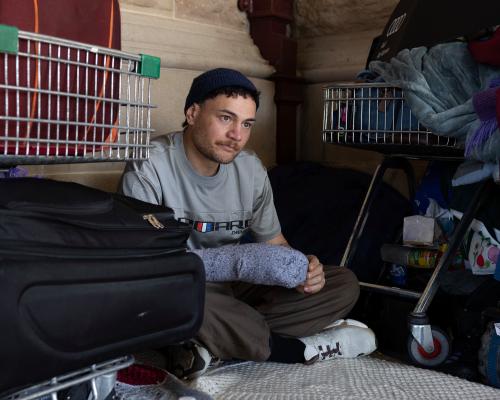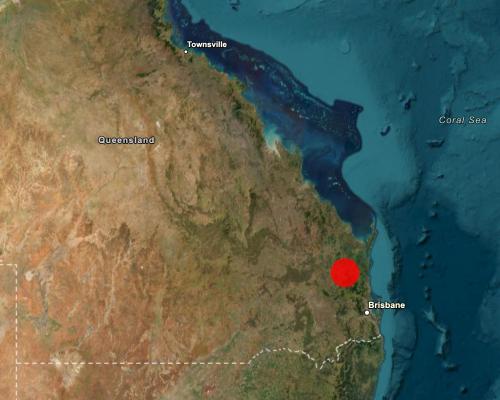
Pari Nikau was woken by being hit in the face with a shovel. He’d been sleeping in a shed on a rooftop near Sydney’s CBD and he thought he was safe.
He remembers playing dead, then blackness.
Hours later, he woke at St Vincent’s hospital, where his head was being stapled.
Two weeks after the 16 June assault, Nikau was told he was being discharged.
“I said ‘I don’t have money, I’m homeless’,” says Nikau, who doesn’t qualify for housing assistance from the government as he is from New Zealand and is not an Australian citizen. “The hospital shouldn’t have let me out unless they knew I’d be cared for.”
Sign up: AU Breaking News email
Nikau briefly moved to a centre that provides accommodation and healthcare to homeless people, before losing that spot.
Now Nikau is among a group of rough sleepers at Sydney’s Central Station struggling with changing rules.
Earlier this month, after a string of increasingly restrictive rules, they were told to move from a sheltered area between 6am until midnight.
“I was in pain, I moved [to Central Station] because I need to sleep,” Nikau says. “And every time I do, they come over and yell at me to move on. I’m over having to repack. I can’t start again.”
‘Inconveniencing passengers’
Since the latest change, Nikau and his friends have moved from the light rail stop to a partially covered area out of the way of passengers. They’re still woken at 6am, but they can return once the morning peak hour is over.
But there’s nowhere to sit, forcing them to huddle on the floor, exposed to the elements. Nikau still has his arm in a cast and is still recovering from multiple wounds.
Amanda, who did not want her surname publish, also doesn’t qualify for housing assistance as she’s American, has been sleeping at the station for two-and-a-half years.
She says Transport for NSW told her the rules had changed due to the “flow of commuters” and “inconveniencing passengers”.
“We said ‘we commuters as well, I take the train multiple times a day’,” says Amanda. “This train station is publicly funded, so why aren’t we allowed to stay here?”
Amanda still stays on the benches near the light rail stop – she has back problems and needs seating. She keeps her belongings tidy: a few suitcases, some backpacks covered in plastic sheeting. So far, she hasn’t been reprimanded, but she says the police treat them “like we’re children”.
“They wake us up like it’s a school day,” she says. “How are we inconveniencing people when we’re not in the way of traffic? It’s ridiculous.”
A NSW police spokesperson says officers can issue move on directions if a person is causing, or is likely to cause, inconvenience to other people on railway premises. “Failure to comply with a move on direction can result in a fine or removal from the premises.
“Being homeless is not an offence, and NSW Police will continue to work with the community and help homeless people make contact with appropriate services if needed.”
‘Where are people supposed to go?’
Kylie Emery, who has been sleeping at Central Station while grappling with complex trauma and PTSD, has been looking out for Nikau. She’s been recovering from the “worst flu of [her] life”.
“We can’t use the benches because they say we’re disrupting commuters, so I’ve been sleeping in wet clothes in the pouring rain,” she says.
Transport for NSW has recently begun confiscating or disposing of belongings left unattended. Last month, an unattributed poster warned homeless people at Central Station to remove their belongings or they would be “disposed of”, which a spokesperson for Transport for NSW says was a directive from NSW police.
“People looking for their items are referred to the station office where they are assisted,” they say. “If unattended belongings are moved, they are able to be collected. Sydney Trains will hold belongings for at least 24 hours.”
Stephen Devine, who has been staying near the light rail stop for the past few weeks, has been helping to guard his friends’ belongings.
He says one elderly woman went to get hand surgery last Friday, and stayed in hospital overnight. The next morning, all her things were taken. Although she was able to recover her things, he worried that if she had come back a day later, her belongings would have been binned – something he says he has seen happen to other people.
Nikau also found his items had been taken when he returned from the smoking area. After asking a number of people, he found his belongings next to some rubbish bins.
Kira Levin, a solicitor at the Justice and Equity Centre says police can only move people on in public areas in accordance with the Law Enforcement (Powers and Responsibilities) Act, which covers instances where people are obstructing persons or traffic.
She says authorised officers can also remove property if it’s unattended, but there’s also a specific protocol for homeless people in public spaces – which requires that notice be given.
She says the poster was “not appropriate and not clear” as it didn’t specify who was giving the order.
“Creating this confusion is really not helpful.”
Levin says instead of police instructing the homeless people to move on, they should talk to them and find out “why there are a growing number of people sleeping there”.
“Where are people supposed to go is my question,” she says. “There’s a limited number of places in Sydney where there’s shelter and CCTV.”
A worsening problem
According to a state government count, the number of rough sleepers has grown by nearly 70% in five years, from 1,314 in 2020 to 2,192 in 2025.
Levin says many have difficulty finding temporary accommodation or social housing, as they can lack identification, be unable to pay or may not be a permanent resident.
“You need to engage with people in a way that’s trauma informed, explaining what’s happening, and giving options about where they’re supposed to go,” she says.
The NSW minister for homelessness, Rose Jackson, says she is “absolutely concerned about the situation at Central Station”.
“No one should be forced to live rough. It’s not safe, it’s not dignified, and we have a responsibility to do better,” she says.
“We’ve already surged services in the area to connect people with support, accommodation and long-term housing pathways.”
Jackson says the state government has provided the largest investment in homelessness services in NSW history, including a $6.6bn Building Homes for NSW program, focused on social housing and homelessness support.
“We know the system hasn’t worked. But we are rebuilding it,” she says. “People experiencing homelessness are not problems to be managed.”
For Nikau, all he wants is a place to rest and recuperate.
“I’m constantly scared to sleep,” he says. “Where is the compassion? I don’t get the support a lot of other people do, but I always want to help others. I’ll give someone my spare shoes. But people just ignore us.”
With additional reporting by Luca Ittimani





